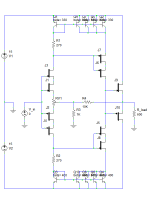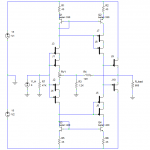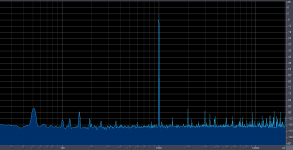I've been pondering making a design for a discrete op-amp. Something that is not too complex and yet offers performance as good as IC op-amps.
Attached is one design I am considering (only simulated at the moment - it's too damned hot to do any real work). It has a single-ended input instead of differential for simplicity (lower component count plus no need for Miller compensation). This makes it 'current feedback' (as in low-impedance feedback node - not to be confused with 'current feedback' meaning feedback proportional to output current).
Biasing for the Vas is accomplished with current mirrors. This helps with symmetry, in particular compensating for the potentially unequal Vgs of the two Vas JFETs.
Both the input stage and Vas are cascoded, which in conjunction with the current mirrors provides both constant current and constant voltage operation for those transistors, minimizing thermal memory distortion.
Output stage uses JFETs, for simplicity.
Simulated performance compares well with IC op-amps, with 134dB of open-loop gain, 30MHz GBP, very high input impedance, low output impedance, low distortion and around 180V/us of slew-rate. It's not quite as simple as I had set out to create, but it's not too bad.
Comments and criticism welcome!
Attached is one design I am considering (only simulated at the moment - it's too damned hot to do any real work). It has a single-ended input instead of differential for simplicity (lower component count plus no need for Miller compensation). This makes it 'current feedback' (as in low-impedance feedback node - not to be confused with 'current feedback' meaning feedback proportional to output current).
Biasing for the Vas is accomplished with current mirrors. This helps with symmetry, in particular compensating for the potentially unequal Vgs of the two Vas JFETs.
Both the input stage and Vas are cascoded, which in conjunction with the current mirrors provides both constant current and constant voltage operation for those transistors, minimizing thermal memory distortion.
Output stage uses JFETs, for simplicity.
Simulated performance compares well with IC op-amps, with 134dB of open-loop gain, 30MHz GBP, very high input impedance, low output impedance, low distortion and around 180V/us of slew-rate. It's not quite as simple as I had set out to create, but it's not too bad.
Comments and criticism welcome!
Attachments
Mr Evil said:Comments and criticism welcome!
Interesting and imaginative. Let us know how the simulations
sound.
Re: Re: Simple(ish) discrete op-amp
Compensation is not needed. It should be unity-gain stable, with the caveat that comes with current-feedback designs that the resistor from output to feedback node must be present and of sufficiently high value (I haven't worked out the minimum yet). Of course that might be different in reality.
Argh! Every time I think up something that could be a little novel, someone posts something prior that's very similar! Hmph.vAD said:At first sight like all it is good, but something guards. Did not look more deeply.
For the information look.
J5/6 are cascodes. Normally you see JFET cascodes with their gates connected to the source of the other transistor, but having thought a little about it I think it's better to connect the cascode's gate to the gate of the other transistor (I've seen this done somewhere else, which is what made me think about it). My reasoning is this: Normally, the cascode FET holds Vds of the other transistor at its Vgs. Ideally this is a constant, but because of finite gain of the cascode it will actually change with current. However, if it's referenced to the gate of the other transistor instead, assuming both transistors are identical, then the change in the cascode's Vgs will be exactly matched by the Vgs of the other transistor, meaning Vds is independent of current.darkfenriz said:Hi
what are J5 & J6 for?
How about compensation and stability issues?
What's the minimal (closed loop) gain?
I like its simplicity, but I don't understand the issues above so it's hard to comment now.
best regards
Compensation is not needed. It should be unity-gain stable, with the caveat that comes with current-feedback designs that the resistor from output to feedback node must be present and of sufficiently high value (I haven't worked out the minimum yet). Of course that might be different in reality.
Don't worry, I'll be exercising real transistors as soon as the temperature drops below sweltering.Nelson Pass said:
Interesting and imaginative. Let us know how the simulations
sound.
In practise, your current mirrors will need emitter resistors. And, when you add them, you can easily multiply current without needing multiple transistors - just divide the corresponding leg emitter resistor with the current multiplier.
Otherwise, it looks very interesting! Let us know how it works for real when you ave the chance to try it out...
Otherwise, it looks very interesting! Let us know how it works for real when you ave the chance to try it out...
Re: Re: Re: Simple(ish) discrete op-amp
Excuse, it was very fast the thrown sight, but all the same, there will be a feeling that it to work well.
Very interestingly, did not know, whether there is really working circuit.
ilimzn (In practise, your current mirrors will need emitter resistors.) completely I support.
Excuse, it was very fast the thrown sight, but all the same, there will be a feeling that it to work well.
Mr Evil said:
J5/6 are cascodes. Normally you see JFET cascodes with their gates connected to the source of the other transistor, but having thought a little about it I think it's better to connect the cascode's gate to the gate of the other transistor (I've seen this done somewhere else, which is what made me think about it). My reasoning is this: Normally, the cascode FET holds Vds of the other transistor at its Vgs. Ideally this is a constant, but because of finite gain of the cascode it will actually change with current. However, if it's referenced to the gate of the other transistor instead, assuming both transistors are identical, then the change in the cascode's Vgs will be exactly matched by the Vgs of the other transistor, meaning Vds is independent of current.
Compensation is not needed. It should be unity-gain stable, with the caveat that comes with current-feedback designs that the resistor from output to feedback node must be present and of sufficiently high value (I haven't worked out the minimum yet). Of course that might be different in reality.
Very interestingly, did not know, whether there is really working circuit.
ilimzn (In practise, your current mirrors will need emitter resistors.) completely I support.
Re: Re: Re: Simple(ish) discrete op-amp
So it is necessary to think up, that that really new.
Mr Evil said:
Argh! Every time I think up something that could be a little novel, someone posts something prior that's very similar! Hmph.
.
So it is necessary to think up, that that really new.
Pressed the breadboard into service today. The built circuit is the one attached to this post: Changed to Widlar current mirrors, as per ilimzn's suggestion, although I had to reduce their current gain to 1 due to having run out of higher Idss JFETs for the Vas stage; I seem to use up a lot of them. Removed input stage drain resistors (R1/2 in the original schematic), since they don't really help much.
Performance seems close to the sims, as far as I can tell with my aging equipment. Testing did bring to light one thing which I neglected to simulate: PSRR, which isn't that good. Also DC offset drifts a bit. It sounds good though (of course ).
).
I'll probably put together a PCB at some point. A small board with five pins so it can be plugged in wherever. It's a shame there don't seem to be any SMT complementary JFETs, or I could try making one that would fit in a DIP socket.
Performance seems close to the sims, as far as I can tell with my aging equipment. Testing did bring to light one thing which I neglected to simulate: PSRR, which isn't that good. Also DC offset drifts a bit. It sounds good though (of course
I'll probably put together a PCB at some point. A small board with five pins so it can be plugged in wherever. It's a shame there don't seem to be any SMT complementary JFETs, or I could try making one that would fit in a DIP socket.
Attachments
Sorry to say, but I could have told you PSRR would be poor.
Maybe if the cascodes were BJT's it might have been better than high transconductance FETs. Still it's always better to find out yourself (my daughter is a prime example). Trouble is it throws the onus onto the PS and with signal levels and noise, limits are there.
All part of growing up and being British, yes? Further folly will demand reporting to the ministry of silly concepts and you will not be let out so often. Sorry Erno.
Cheers,
Greg
Maybe if the cascodes were BJT's it might have been better than high transconductance FETs. Still it's always better to find out yourself (my daughter is a prime example). Trouble is it throws the onus onto the PS and with signal levels and noise, limits are there.
All part of growing up and being British, yes? Further folly will demand reporting to the ministry of silly concepts and you will not be let out so often. Sorry Erno.
Cheers,
Greg
When I said the PSRR isn't that good, I didn't mean it was terrible or anything. Sims say it starts at 100dB and falls to zero at about 1MHz where a good op-amp might manage to keep above zero to 10MHz or more. The real circuit seems a bit worse, but that's not unexpected considering it's on a breadboard made using unmatched components. On the plus side, the PSRR is approximately symmetrical, whereas op-amps tend to have worse PSRR on one rail.
Yes it really works. I never make anything that doesn't work!
It's set up on a breadboard and I've been running a few tests on it. I'm pleased so far. The only thing that really lets it down is that the DC offset drifts quite a lot (about +/-50mV). I expect I could minimize that by biasing the input JFETs at the zero tempco point, but that's not practical with the particular ones I've got in there at the moment (need ones with larger Vp).
I've attached an FFT with a 1kHz sine wave input, 1V rms output. Much of the noise is from my RFI-happy computer (50Hz + harmonics and some high frequencies). Also note that the distortion will really be somewhat better than this, since the FFT also shows the distortion from the soundcard itself. Still, it's not too shabby with all harmonics below 90dB.
It's set up on a breadboard and I've been running a few tests on it. I'm pleased so far. The only thing that really lets it down is that the DC offset drifts quite a lot (about +/-50mV). I expect I could minimize that by biasing the input JFETs at the zero tempco point, but that's not practical with the particular ones I've got in there at the moment (need ones with larger Vp).
I've attached an FFT with a 1kHz sine wave input, 1V rms output. Much of the noise is from my RFI-happy computer (50Hz + harmonics and some high frequencies). Also note that the distortion will really be somewhat better than this, since the FFT also shows the distortion from the soundcard itself. Still, it's not too shabby with all harmonics below 90dB.
Attachments
mr. evil and others:
nice circuit. i like your thinking, too.
based on a hint from a post in "the other place" by andy_c, i have been looking at some other jfets to use in those areas when i need higher idss than provided by the 2SK170 and 2SJ74. i think the part numbers are J175 (p) and J111 , but i have to check at home.
, but i have to check at home.
here in the states, these are available directly from fairchild for under $0.20 each. i'd imagine they're available from other suppliers also, such as vishay or interfet or linear systems ...
yeah, they're spec'd for switching type applications. and they not exactly designed to be complimentary pairs. but, one can make similar statements about those big mosfets that mr. pass likes.

and borbely used jfet analog switches in one of his amp designs from the past.
just fyi ...
so, have you listened yet? how does it sound?
mlloyd1
and
nice circuit. i like your thinking, too.
based on a hint from a post in "the other place" by andy_c, i have been looking at some other jfets to use in those areas when i need higher idss than provided by the 2SK170 and 2SJ74. i think the part numbers are J175 (p) and J111
here in the states, these are available directly from fairchild for under $0.20 each. i'd imagine they're available from other suppliers also, such as vishay or interfet or linear systems ...
yeah, they're spec'd for switching type applications. and they not exactly designed to be complimentary pairs. but, one can make similar statements about those big mosfets that mr. pass likes.
and borbely used jfet analog switches in one of his amp designs from the past.
just fyi ...
so, have you listened yet? how does it sound?
mlloyd1
and
Mr Evil said:... due to having run out of higher Idss JFETs for the Vas stage; I seem to use up a lot of them...
- Status
- This old topic is closed. If you want to reopen this topic, contact a moderator using the "Report Post" button.
- Home
- Amplifiers
- Solid State
- Simple(ish) discrete op-amp


